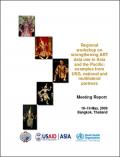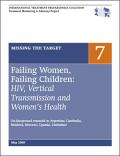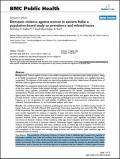What's New
Displaying results 4181 - 4190 of 4914

Resource | Publications,
The global economic crisis threatens recent gains in health and poverty reduction in developing countries. What is the effect of the crisis on HIV programmes, especially in high HIV prevalence countries? What are the possible consequences? What can be done to avoid negative impacts? Advanced economies are projected to suffer deep recessions in 2009, with their gross domestic product (GDP) contracting by 5% on average—the first such fall in 60 years. This is generating fears that official development assistance, and in particular resources for social sector spending, including funding for HIV services and commodities, would remain flat during the next few years.

Resource | Fact Sheets,
Human immunodeficiency virus (HIV)/acquired immunodeficiency syndrome (AIDS) remains an important public health challenge in Singapore. The number of newly diagnosed HIV-infected cases has been steadily increasing over the past decade, mirroring the trend in other Asian countries.
Singapore’s multi-pronged National HIV/AIDS Control Programme comprises education of the general public and high-risk groups, legislation, protection of the national blood supply through screening of blood and blood products, management of cases and contact tracing, epidemiological surveillance, and scaling up the prevention and control of conventional sexually-transmitted infections (STIs).

Resource | Publications,
In April 2008, ADB approved DOH’s request for funding to enable the conduct of studies and other activities under the project,“Supporting Women at-Risk and Vulnerable to HIV/AIDS in the Philippines.” ADB provided funding through the Gender and Development Cooperation Fund (GDCF) established under RETA 6143, which supports initiatives to promote gender mainstreaming in ADB operations, gender capacity development, and strategic partnerships.

Resource | Guidelines,
The National Gender Equality Policy and Framework for Action consolidates President Mohamed Nasheed’s women's policy framework announced in the International Women’s Day (2009) statement into public policy. The draft includes recommendations for an effective NWM/ Lead Agency for gender mainstreaming, and the tools for gender mainstreaming, and is targeted at realising change through coherent, focused, strategic, rights-based, result-oriented action for gender equality.

Resource | Publications,
Antiretroviral treatment (ART) is extending the lives of people living with HIV (PLHIV). Though ART has become more widely accessible globally since the early 1990s, getting antiretroviral drugs (ARV) to those who need it most continues to be a challenge. As access increases, so does the need to assure that systems are in place to report on outputs and outcomes in a timely manner. Such data are vital to ART programs, as not only do they assist in tracking progress towards achieving global goals, but they also inform the day to day implementation of treatment programs. Without an adequate measurement of what is being done, countries risk losing opportunities to prevent premature deaths and potential ARV resistance; they also do not have the information critical to assure PLHIV on ART receive appropriate care at the appropriate time to improve and maintain their quality of life.
Acknowledging the need to share experiences and lessons learned in order to inform future direction, the U.S. Government (USG), World Health Organization (WHO) and other partners organized the first “Regional workshop on strengthening ART data use in Asia and the Pacific: examples from USG, national and multilateral partners” in Bangkok, Thailand from 18-19 May 2009. This two day workshop provided a forum for national and international experts to present lessons learned and discuss specific challenges faced in most resource-poor settings throughout the region.

Missing the Target 7: Failing Women, Failing Children: HIV, Vertical Transmission and Women’s Health
Resource | Publications,
Governments and UN agencies have failed to meet their international commitments and should be called to account. Despite the relative ease of delivering the antiretroviral prophylaxis to prevent vertical transmission progress has been slow, with global coverage rising from 9 percent in 2004 to 33 percent coverage in 2007. At least three quarters of HIV-positive pregnant women in 61 countries, including Cameroon, Ethiopia, India and Nigeria, are still not receiving this intervention.
Moreover, it is not enough merely to ensure access to ARV prophylaxis. Quality is equally important, and in this regard too the options for women in poorer countries are far less appropriate and effective. In the developed world, all women who want and need ARV prophylaxis can obtain triple-dose combination therapy, which reduces the risk of vertical transmission to a mere 2 percent. About half of women receiving ARV prophylaxis in the global South, meanwhile, are provided with single-dose nevirapine treatment. This regimen reduces transmission risk by just over 40 percent, however, and puts women under the risk of developing resistance to nevirapine, which is the backbone of many HIV treatment regimens in general.
Our research for this report, Missing the Target 7, has reinforced the need for governments, UN agencies, donors and indeed civil society to look beyond the magic bullet of administering a pill each to mother and baby in order to stem the annual toll of preventable infections and deaths in newborns.

Resource | Laws and Policies,
These guidelines are intended to provide guidance on PMTCT of HIV among sexually transmitted infection (STI), maternal and child health (MCH), family planning (FP), sexual and reproductive health (SRH) service providers covering public and private, community-based health facilities and the civil society.

Resource | Publications,
Injecting drug users (IDU) are at increased risk of human immunodeficiency virus (HIV) infection. Their HIV prevalence however varies from place to place and may not be directly linked with the level of individual risk. This study explores the relative importance of individual and community level characteristics in the practice of HIV-related risk behaviors in IDU in Hong Kong where the HIV prevalence has remained low at below 1%.
Methadone clinics were used as the channel for accessing drug users in Hong Kong. HIV-related risk factors in drug users attending these clinics were retrieved from a questionnaire routinely administered to newly admitted and readmitted clients, and assessed using logistic regression and multilevel analyses.

Resource | Presentations,
This presentation is about:
- Epidemiology of HIV among young people in Asia
- The ‘window of opportunity’ - mostly HIV negative young people in schools in Asia
- One size fits who? The need to let data direct tailored strategies, policies and programs
- General policy and programming implications
- Implications for education sector responses

Resource | Publications,
Violence against women is now widely recognised as an important public health problem, owing to its health consequences. Violence against women among many Indian communities on a regularly basis goes unreported. The objective of this study is to report the prevalence and other related issues of various forms of domestic violence against women from the eastern zone of India.
The prevalence of domestic violence in Eastern India is relatively high compared to majority of
information available from India and confirms that domestic violence is a universal phenomenon. The primary healthcare institutions in India should institutionalise the routine screening and treatment for violence related injuries and trauma. Also, these results provide vital information to assess the situation to develop public health interventions, and to sensitise the concerned agencies to implement the laws related to violence against women.





